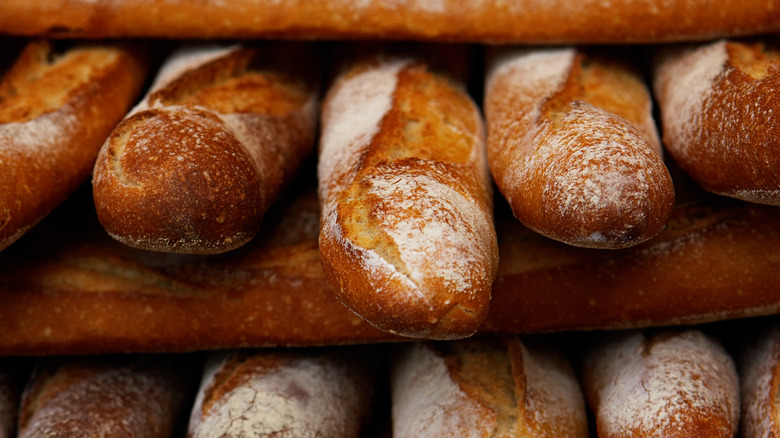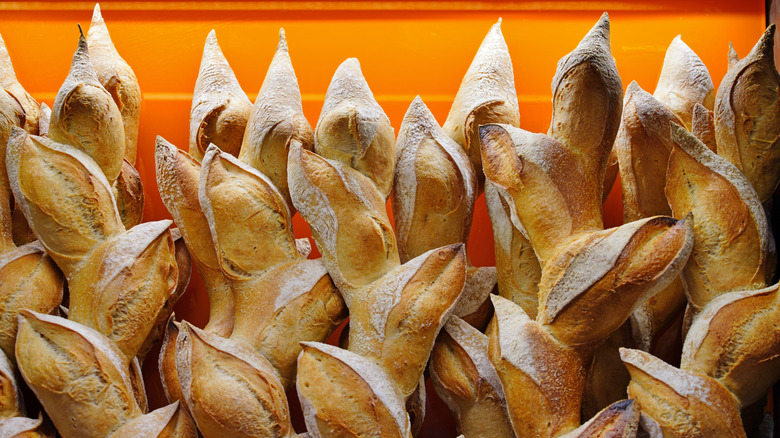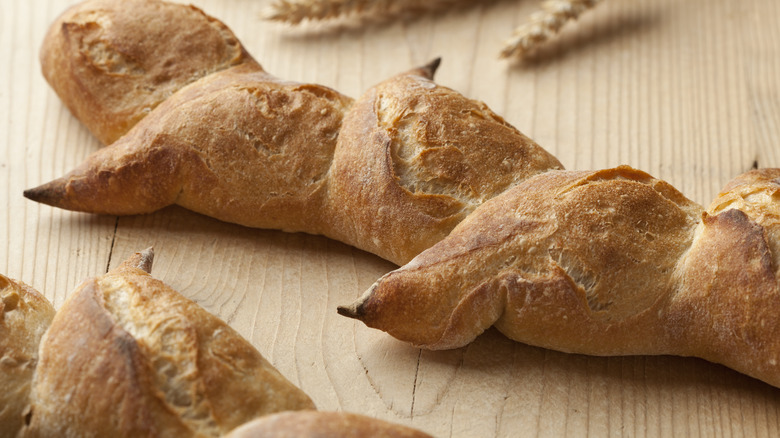What Is Pain D'epi (And Why Is It Known As French Pull-Apart Bread)?
We may receive a commission on purchases made from links.
The French take their bread very seriously. They recently sought and achieved an important cultural milestone for the classic French baguette, earning a spot on UNESCO's list of Intangible Cultural Heritage. That designation is reserved for traditions, and expertise that have become "an integral part of human culture." That's some high praise for a simple combination of flour, yeast, salt, and water. The skill of French bakers to use centuries of technique to elevate the humble baguette is worthy of that rare designation.
Long, thin, baguettes are just one shape the same dough can take. The most common types and shapes of French bread are well defined. Typically, the names simply describe the shape, and Masterclass runs through the highlights. Baguette is a stick, or baton. So, a half size baguette is demi, or half. Ficelle means string, so that loaf is long and thin. Boule is a ball, so that loaf is round. An oblong loaf that's somewhere between a boule and a baguette is called a batard, or bastard. Ouch. Among these entries is the pain d'epi, which is a delicious pull-apart treat.
Pain d'epi is French pull-apart bread
One of the more interesting shapes a baguette can take is in the form of an ear of wheat. Pain is the French word for bread, and epi means ear, in terms of the "fruiting part of grain." These striking loaves certainly look the part, as the baguette is segmented into a long row of alternating spikes of bread, according to Masterclass.
Pain d'epi has a dramatic presentation that does a lot more than make an impression on a dinner table. If your favorite part of bread is the crust, the epi shape is for you. All of those alternating mini loaves maximize the amount of surface area to become golden brown and crisp. Still, the interior remains soft, and pillowy, like a great dinner roll. Best of all, these segments can be easily pulled apart at the table without needing to use a knife. It might be the original savory monkey bread recipe.
Pain d'epi is a great way to upgrade homemade bread
Don't let the fancy French name, or the deft mimicking fool you. Making pain d'epi is a very simple technique. All you need is a pair of kitchen shears. Heavy duty kitchen scissors are a must-have kitchen gadget that will make a gorgeous loaf of pull-apart bread.
Anyone can make great crusty baguettes, so anyone can make pain d'epi. After shaping and rolling the dough into a long cylinder, you've got the baguette down. For the epi, hold the shears, or scissors, wide open, and at an angle on one end of the loaf. Make a quick, confident cut that goes most of the way through the loaf. Slide this segment to one side. Repeat this every few inches for the entire length while alternating the direction of the segments. If you're confused, a quick search for "pain d'epi" will provide plenty of guidance. Ditto for any other of the classic shapes.
Not that a delicious pain d'epi needs upgrading, but you could experiment and add fillings. Rolling sliced ham and gruyere into the dough while rolling the baguette shape won't earn you any love from UNESCO, but it will make for a striking, and tasty, loaf of bread.


